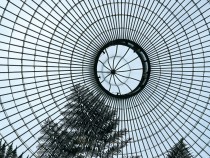
© Christian Schittich
They are among the nineteenth century’s most fascinating structures, yet tend to be overlooked by classical architectural history: the lacelike greenhouses of iron and glass whose form and articulation are derived solely from functional and technical requirements.
New construction methods and formal innovations – later to become fundamentals of modern architecture – are brought to bear in these early manifestations of industrialised construction. Because their erecters – typically gardeners or engineers – were completely unburdened by the conventions of the architecture of their time and questions of style, they were able to employ unusual material combinations as well as the nascent potential of prefabricated construction – but also experiment with hitherto unknown aesthetics. And the building codes for these purely utilitarian structures for plants – initially, stays of longer duration by people were not foreseen – allow considerable leeway.
These factors, in combination with incipient industrialised methods for the production of iron and glass, during a phase in which an increasing number of exotic plants was arriving in Europe from the colonies – aristocrats and wealthy individuals were keen to cultivate and exhibit them – led to the construction of unprecedented spaces. (Christian Schittich)
New construction methods and formal innovations – later to become fundamentals of modern architecture – are brought to bear in these early manifestations of industrialised construction. Because their erecters – typically gardeners or engineers – were completely unburdened by the conventions of the architecture of their time and questions of style, they were able to employ unusual material combinations as well as the nascent potential of prefabricated construction – but also experiment with hitherto unknown aesthetics. And the building codes for these purely utilitarian structures for plants – initially, stays of longer duration by people were not foreseen – allow considerable leeway.
These factors, in combination with incipient industrialised methods for the production of iron and glass, during a phase in which an increasing number of exotic plants was arriving in Europe from the colonies – aristocrats and wealthy individuals were keen to cultivate and exhibit them – led to the construction of unprecedented spaces. (Christian Schittich)













